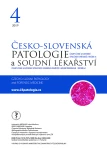Inflammatory myofibroblastic tumor of the uterus – case report
Authors:
Zuzana Štiková 1; Nikola Ptáková 1; Markéta Horáková 1,3; Jan Kosťun 2; Ondrej Ondič 1,3
Authors‘ workplace:
Bioptická laboratoř s. r. o., Plzeň
1; Gynekologicko-porodnická klinika, LF UK a FN Plzeň
2; Šiklův ústav patologie, LF UK a FN Plzeň
3
Published in:
Čes.-slov. Patol., 55, 2019, No. 4, p. 239-243
Category:
Original Articles
Overview
Inflammatory myofibroblastic tumor (IMT) of the uterus is rare but probably underdiagnosed tumor. It is usually benign but small fraction of cases may locally recur or rarely metastasize. Herein, we present a case report of 66-year-old patient with uterine IMT originally diagnosed as leiomyosarcoma of the uterus. The patient died within few months due to local tumor progression with skeletal metastases. Macroscopically, this was a voluminous locally aggressive yellowish-grey tumor of soft consistency limited to myometrium. Microscopically, the tumor was characterized by polymorphic spindle cell proliferation with marked nuclear atypia and numerous mitoses. Small geographic necroses was noticed. Typical histologic features of IMT were represented by lymphocytic infiltrate which was only very small and focal. Myxoid stroma was absent. Immunohistochemically, there was strong and diffuse cytoplasmic positivity of ALK (anaplastic lymphoma kinase). The presence of PPP1CB-ALK fusion transcript was confirmed by molecular-genetic methods. Proper diagnosis of uterine IMT is of importance as there is an option of targeted ALK inhibitor therapy in cases of aggressive tumor behaviour. Currently it is thought that histomorphology of uterine IMT may overlap with that of leiomyosarcoma and STUMP (smooth muscle tumor of uncertain malignant potential). The presence of ALK rearrangement is probably the only reliable diagnostic marker. Thus, ALK immunohistochemistry followed by molecular-genetic testing seems to represent suitable screening tool for the detection of uterine IMT.
Keywords:
Leiomyosarcoma – inflammatory myofibroblastic tumor – IMT – STUMP – Uterus – ALK-rearranged mesenchymal tumors – PPP1CB-ALK fusion – tyrosin kinase inhibitors
Sources
1. Coffin CM, Fletcher JA. Inflammatory myofibroblastic tumor. In: Fletcher CDM, Bridge JA, Hogendoorn PCW, Mertens F, eds. World Health Organization Classification of Tumours of Soft Tissue and Bone (4th ed.). IARC Press: Lyon; 2013: 83–84.
2. Gilks CB, Taylor GP, Clement PB. Inflammatory pseudotumor of the uterus. Int J Gynecol Pathol 1987; 6(3): 275–286.
3. Bennett JA, Nardi V, Rouzbahman M, Morales-Oyarvide V, Nielsen GP, Oliva E. Inflammatory myofibroblastic tumor of the uterus: a clinicopathological, immunohistochemical, and molecular analysis of 13 cases highlighting their broad morphologic spectrum. Mod Pathol 2017; 30(10): 1489–1503.
4. Coffin CM, Patel A, Perkins S, Elenitoba-Johnson KS, Perlman E, Griffin CA. ALK1 and p80 expression and chromosomal rearrangements involving 2p23 in inflammatory myofibroblastic tumor. Mod Pathol 2001; 14(6): 569–576.
5. Fuehrer NE, Keeney GL, Ketterling RP, et al. ALK-1 protein expression and ALK gene rearrangements aid in the diagnosis of inflammatory myofibroblastic tumors of the female genital tract. Arch Pathol Lab Med. 2012; 136(6): 623–626.
6. Parra-Herran C, Quick CM, Howitt BE, et al. Inflammatory myofibroblastic tumor of the uterus: clinical and pathologic review of 10 cases including a subset with aggressive clinical course. Am J Surg Pathol 2015; 39(2): 157–168.
7. Ptáková N, Miesbauerová M, Kosťun J, et al. Immunohistochemical and selected genetic reflex testing of all uterine leiomyosarcomas and STUMPs for ALK gene rearrangement may provide an effective screening tool in identifying uterine ALK-rearranged mesenchymal tumors. Virchows Arch 2018; 473(5): 583–590.
8. Devereaux KA, Kunder CA, Longacre TA. ALK-rearranged tumors are highly enriched in the STUMP subcategory of uterine tumors. Am J Surg Pathol 2019; 43(1): 64–74.
9. Pickett JL, Chou A, Andrici JA, et al. Inflammatory myofibroblastic tumors of the female genital tract are under-recognized: a low threshold for ALK immunohistochemistry is required. Am J Surg Pathol 2017; 41(10): 1433–1442.
10. Parra-Herran C, Schoolmeester JK, Yuan L, Dal Cin P, Fletcher CD, Quade BJ, Nucci MR. Myxoid leiomyosarcoma of the uterus: a clinicopathologic analysis of 30 cases and review of the literature with reappraisal of its distinction from other uterine myxoid mesenchymal neoplasms. Am J Surg Pathol 2016; 40(3): 285–301.
11. Hoang LN, Aneja A, Conlon N, et al. Novel high-grade endometrial stromal sarcoma: a morphologic mimicker of myxoid leiomyosarcoma. Am J Surg Pathol 2017; 41(1): 12–24.
12. Haimes JD, Stewart CJR, Kudlow BA, et al. Uterine inflammatory myofibroblastic tumors frequently harbor ALK fusions with IGFBP5 and THBS1. Am J Surg Pathol 2017; 41(6): 773–780.
13. Subbiah V, McMahon C, Patel S, et al. STUMP un „stumped“: anti-tumor response to anaplastic lymphoma kinase (ALK) inhibitor based targeted therapy in uterine inflammatory myofibroblastic tumor with myxoid features harboring DCTN1-ALK fusion. J Hematol Oncol 2015; 8: 66.
14. Aghajan Y, Levy ML, Malicki DM, Crawford JR. Novel PPP1CB-ALK fusion protein in a high-grade glioma of infancy. BMJ Case Rep 2016; 2016: bcr2016217189.
15. Ferreira J, Félix A, Lennerz JK, Oliva E. Recent advances in the histological and molecular classification of endometrial stromal neoplasms. Virchows Arch 2018; 473(6): 665–678.
16. McCluggage WG, Lee CH. YWHAE-NUTM2A/B translocated high-grade endometrial stromal sarcoma commonly expresses CD56 and CD99. Int J Gynecol Pathol. 2019; 38(6): 528-532.
Labels
Anatomical pathology Forensic medical examiner ToxicologyArticle was published in
Czecho-Slovak Pathology

2019 Issue 4
Most read in this issue
- Clinical perspective on the myocarditis and cardiomyopathies
- Fumarate hydratase deficient renal cell carcinoma and fumarate hydratase deficient-like renal cell carcinoma: Morphologic comparative study of 23 genetically tested cases
- A practical approach to the examination of the congenitally malformed heart at autopsy
- Inflammatory myofibroblastic tumor of the uterus – case report
